Month: April 2022
Remembering a ‘Sip-In’ for Gay Rights 56 Years Later
April 22, 2022
By: Leah Foreman
A permanent plaque at Julius’ Bar to commemorate the fight against discrimination
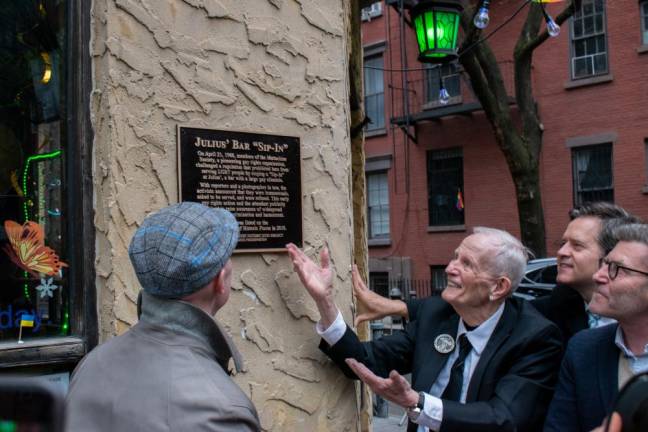
Fifty-six years ago, at Julius’ Bar in Greenwich Village, four openly gay men held a “Sip-In.”
The men were Dick Leitsch, Craig Rodwell, John Timmons and Randy Wicker and they were part of an early gay rights group known as the Mattachine Society. Leitsch and Rodwell were the New York chapter of the Mattachine Society’s president and vice president respectively.
On April 21, 1966, they traveled to various city bars with reporters to document the discrimination they faced under the New York State Liquor Authority, which prevented suspected gay or lesbian people from being served alcohol. After arriving at Julius’, they told the bartender they were homosexuals and he put his hand over a glass in front of them, denying them service.
This moment was captured in a photograph for the Village Voice by the late photographer Fred W. McDarrah. This resulted in unprecedented coverage of LGBTQ activism and civil rights.
The event later led to a change in NYSLA policy.
Today, this history is often overlooked. And Randy Wicker is the only surviving member of the Mattachine’s “Sip-In” left to tell the tale.
“When we took this action, we were legally challenging the state laws that said it was illegal to serve homosexuals alcohol or shall allow them to gather on your premises – that’s right of assembly,” Wicker said. “And by taking that legal action, setting that house of cards in order, we cracked the chain that held the Village and held the gay community in this country locked in the hands of the criminal underground.”
“Make Invisible History Visible”
More than 50 years later to the day, people gathered on West 10th Street to celebrate the bar and its history as a permanent plaque was installed to enshrine its contribution to gay civil rights. Julius’ is also the city’s oldest gay bar.
“Today we make an invisible history visible by installing a commemorative plaque on the exterior of Julius’ Bar, an important location in LGBTQ history,” Ken Lustbader, a founder of NYC LGBT Historic Sites Project, said to the crowd.
When NYC LGBT Historic Sites Project was organized in 2015 to protect historically significant sites, Julius’ was the site on the list, which entered the National Register of Historic Places in 2016. Julius’ became the second LGBTQ site in the country on the register, after The Stonewall Inn, which got on in 1999.
The Greenwich Village Society for Historical Preservation worked in concert with NYC LGBT Historic Sites Project to get Julius’ recognized.
“What we’re doing is we’re helping people understand that the process of getting to where we were today was a long and slow one that took a lot of bravery, a lot of perseverance, and a lot of forward thinking by a lot of people —not all of whom are that well remembered today, but they should be,” said Andrew Berman, the executive director of GVSHP.
Plea for Donations
The plaque unveiling was held on the 56th Anniversary of the “Sip-In” and the six-year anniversary of when Julius’ got on the historic registry. It was pushed back because of the bar’s previous financial trouble and to ensure people could celebrate in person.
From shutting down the bar completely before St. Patrick’s Day in 2020 to serving to-go burgers only to limited indoor seating to surviving the brunt of the pandemic, Julius’ has been through the ringer. The bar’s owner, Helen Buford, made a plea for donations.
She received donations from patrons and from the Gil Foundation, a pro-LGBTQ philanthropic organization, which donated $20,000 and pledged to match donations on a GoFundMe created for the bar up to $25,000.
Broadway star and multihyphenate talent John Cameron Mitchell was born three years to the day before the “Sip-In.”
“This place is not going to become a Starbucks,” Mitchell said on April 21 in front of Julius’.
Except for during COVID, Mitchell and his friends have held dance parties at Julius’ once a month.
State Senator Brad Hoylman presented Buford with a certificate honoring Julius’ designation as a historic business in New York.
“I see this as kind of a collective F.U. to Florida and Texas as we stand here,” Hoylman said. “Because we are not going to let queer history be erased.”
Randy Wicker got up to the podium and spoke after being cajoled by the eager audience.
“So there are two reasons that Julius’ [is] my favorite bar. First of all, it’s because it was the place where we started the ball rolling to liberate our society from the mob. The second is a little bit more personal,” Wicker said as he pulled out a New York Times clipping, encased in plastic. “I got my picture two times on the obituary page of the New York Times. And I’m still here at 84 years old, to tell you about it … and say I’m still here, I’m still fighting. I’m the last Mattichino and will stay active as long as I can.”
I see this as kind of a collective F.U. to Florida and Texas as we stand here. Because we are not going to let queer history be erased. —State Senator Brad Hoylman
Photos: John Cameron Mitchell & More Acknowledge Julius’ Significance to LGBT Activism & History
April 22, 2022
By: Chloe Rabinowitz
Activists, preservationists, historians and others gathered to honor the site of the 1966 “Sip-In” at Julius’, on 56th anniversary of event.
Yesterday, Village Preservation; the NYC LGBT Historic Sites Project; the owner of Julius’ Bar, located at 159 West 10th Street; special guest, Broadway star John Cameron Mitchell; LGBT activist and 1966 “Sip-In” participant, Randy Wicker; and others gathered for the unveiling of a plaque to acknowledge Julius’ significance to LGBT activism and history.
Check out photos below!
On April 21, 1966, members of the Mattachine Society, an early gay rights group, organized what became known as the “Sip-In” to challenge New York State Liquor Authority (SLA) regulations that were promulgated so that bars could not serve drinks to known or suspected gay men or lesbians, since their presence was considered de facto disorderly. The SLA regulations were one of the primary governmental mechanisms of oppression against the gay community because they precluded the right to free assembly. This was particularly important because bars were one of the few places where gay people could meet each other.
Mattachine members Dick Leitsch, Craig Rodwell, and John Timmons, accompanied by several reporters, went to a number of bars to document this discrimination. At Julius’, where they were joined by Randy Wicker, the group announced that they were “homosexuals” and asked to be served a drink – the bartender refused their request. This refusal received publicity in The New York Times and the Village Voice and was the first time LGBTQ discrimination had been proactively documented in mainstream media. The reaction by the SLA and the newly-empowered New York City Commission on Human Rights resulted in a change in policy and the birth of a more open gay bar culture. Scholars of gay history consider the “Sip-In” at Julius’ a key event leading to the growth of legitimate gay bars and the development of the bar as the central social space for urban gay men and lesbians.
Ken Lustbader, NYC LGBT Historic Sites Project: “Today we make an invisible history visible by installing a commemorative plaque on the exterior of Julius’ bar, an important location in LGBTQ history. In April 1966, courageous activists staged a ‘Sip-In’ to publicize the homophobic discrimination that the LGBTQ community experienced in bars, which could refuse them service if suspected of being homosexual. These pre-Stonewall trailblazers challenged the idea that LGBTQ people were second-class citizens – they deserved safe and welcoming places to socialize and build community. The NYC LGBT Historic Sites Project is proud to have undertaken extensive research and writing when nominating Julius’ to the State and National Registers of Historic Places in 2016 for LGBTQ history. Since then, we have nominated an additional ten sites directly associated with LGBTQ history. With the recent pushback of LGBTQ rights and attacks on queer people throughout the country, we’re proud to join with our partners at Village Preservation and Helen Buford, owner of Julius’, to formally memorialize this history with this tangible plaque. It will provide intangible benefits of identity, pride, and a connection to the past.”
Andrew Berman, Village Preservation: “As the city’s oldest gay bar and home of the pioneering 1966 ‘Sip-In’ protesting anti-gay discrimination, we are proud to be placing a plaque at Julius’ with our partners at the NYC LGBT Historic Sites Project to honor this uniquely important civil rights site. Three years before Stonewall, when being gay was still considered a crime, these brave individuals protested for their right to gather free from harassment and discrimination. This is part of a long tradition of pioneering efforts for civil rights for LGBTQ people, African Americans, women, immigrants, and many others rooted in this neighborhood, from the first free black settlement in North America located here in the 17th century, to the fight for Women’s suffrage here in the late 19th and early 20th centuries, to the Stonewall Rebellion and many other agitations for LGBTQ+ rights which took place here in the late 20th century. We’re thrilled to be able to add this site as our 19th historic plaque in our neighborhoods, which have marked the homes of figures from James Baldwin to Jane Jacobs, Lorraine Hansberry to LeRoi Jones, Anais Nin to Alex Haley. We’re especially proud given that in 2012 we were able to get Julius’ determined eligible for the State and National Registers of Historic Places, when few LGBTQ+ sites had ever received such a determination, and we continue to advocate for individual New York City landmark designation for the site.”
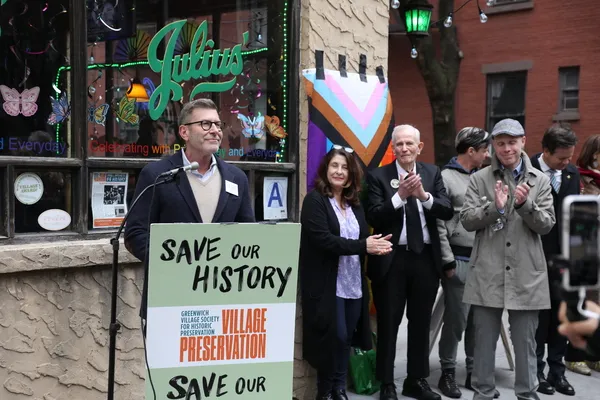
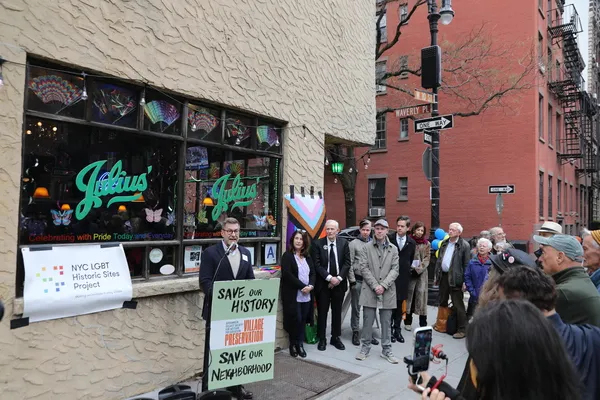
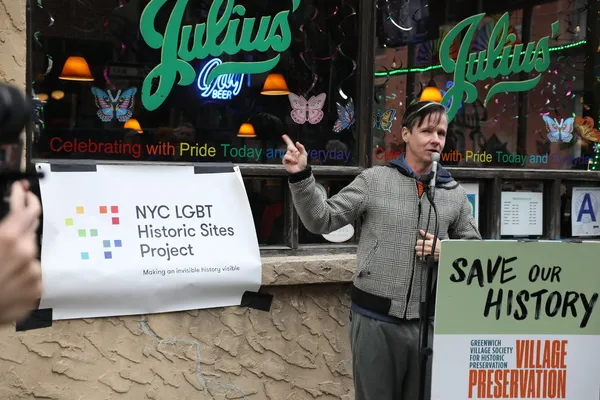
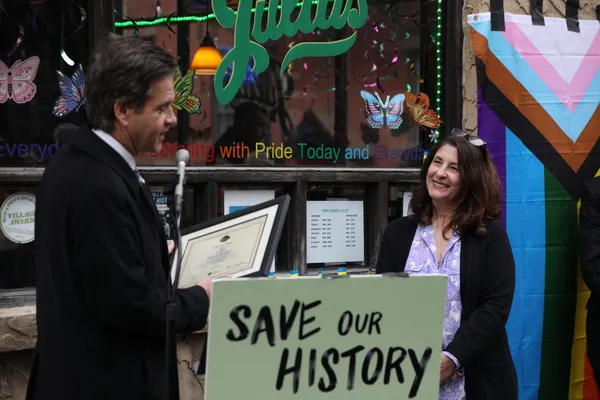
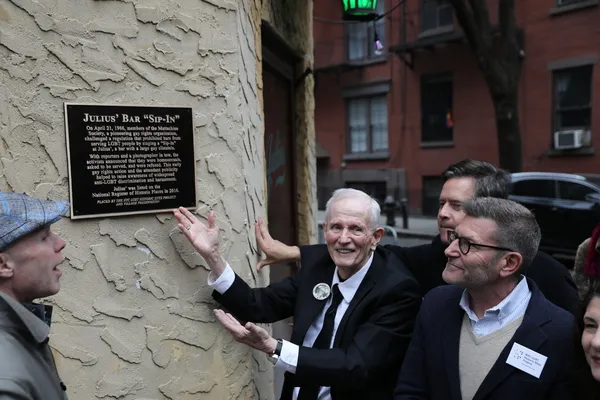
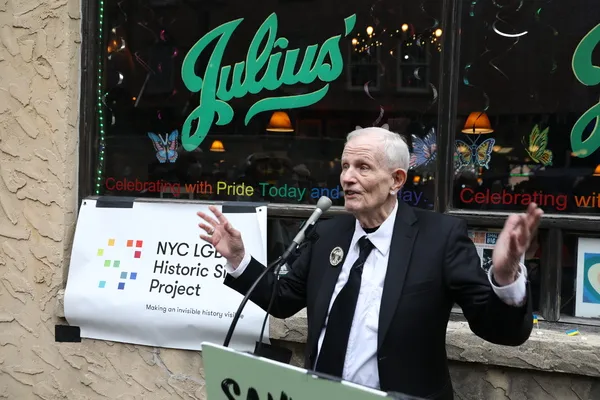
NYC’s oldest gay bar honored with historic plaque
April 25, 2022
By: Aaron Ginsburg
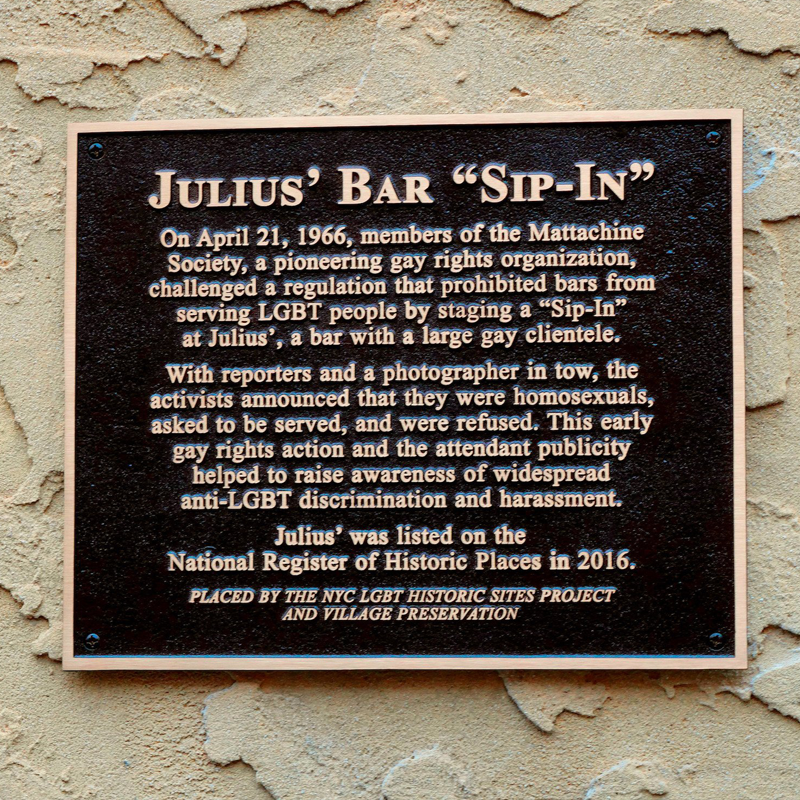
The site of a monumental event in the LGBTQ community’s fight against anti-gay discrimination was honored last week with a historic plaque. The Village Preservation on Thursday unveiled the plaque at 159 West 10th Street, also known as Julius’ Bar. The bar was the site of the first “Sip-In,” an act of defiance in which members of gay rights groups entered the bar and asked to be served drinks while announcing they were homosexuals, going against the discriminatory regulations of the New York State Liquor Authority (SLA) which at the time prohibited bars from serving gays or lesbians.
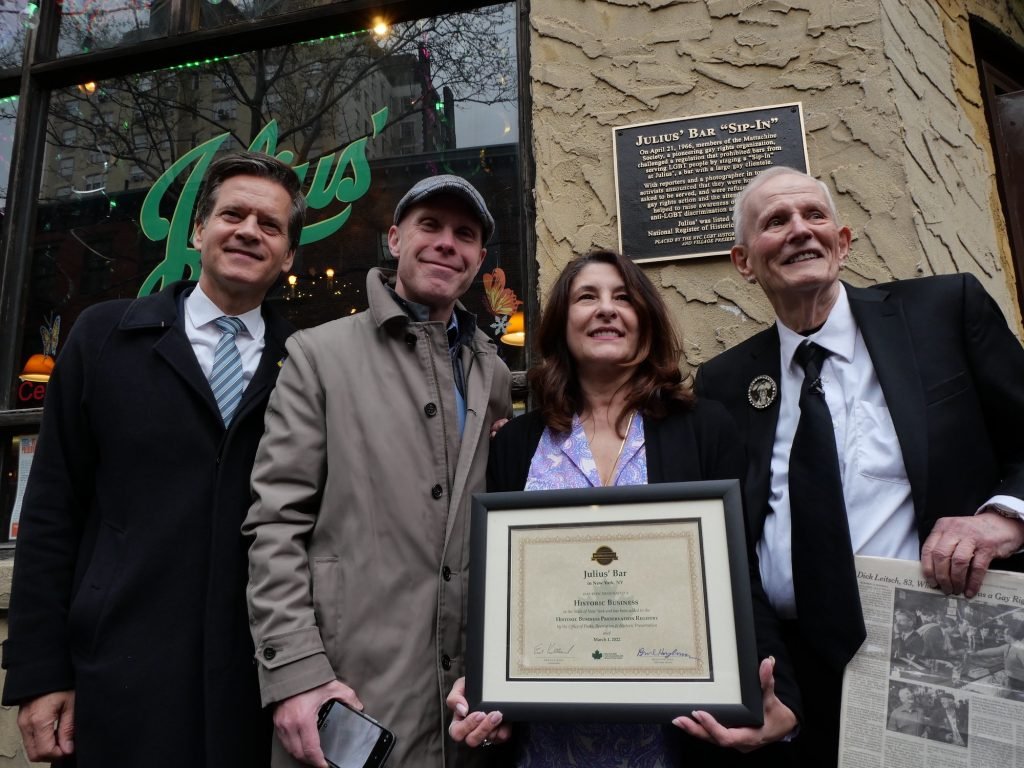
The Village Preservation was joined by the NYC LGBT Historic Sites Project, Broadway star John Cameron Mitchell, and LGBTQ activist and “Sip-In” participant Randy Wicker.
Taking place on April 21, 1966, the first “Sip-In” was led by members of the Mattachine Society, a gay rights group. Members of Mattachine entered a multitude of bars accompanied by reporters to document the discrimination they would face. The members entered Julius’ Bar where they were joined by Wicker and asked the bartender to serve them drinks while announcing they were homosexuals, after which the bartender refused.
The bartender’s refusal was covered in the New York Times and the Village Voice, one of the first times LGBTQ discrimination received significant coverage in the mainstream media. This event led to historic changes in policy and is considered by historians to be a key moment in the creation of legitimate gay bars, an important social space for gay men and lesbians.
“As the city’s oldest gay bar and home of the pioneering 1966 ‘Sip-In’ protesting anti-gay discrimination, we are proud to be placing a plaque at Julius’ with our partners at the NYC LGBT Historic Sites Project to honor this uniquely important civil rights site,” Andrew Berman, Executive Director of Village Preservation, said.
“Three years before Stonewall, when being gay was still considered a crime, these brave individuals protested for their right to gather free from harassment and discrimination.”
The plaque reads: “On April 21, 1966, members of the Mattachine Society, a pioneering gay rights organization, challenged a regulation that prohibited bars from serving LGBT people by staging a “Sip-In” at Julius’, a bar with a large gay clientele.”
The plaque continues: “With reporters and a photographer in tow, the activists announced they were homosexuals, asked to be served, and were refused. This early gay rights action and the attendant publicity helped to raise awareness of widespread anti-LGBT discrimination and harassment.”
This plaque marks the 19th location commemorated by the Village Preservation, which has honored a number of historic homes and establishments in the area. The last unveiling covered by 6sqft was of urbanist Jane Jacob’s Greenwich Village home where she wrote her seminal work, The Death and Life of American Cities.
PHOTOS: Plaque Unveiled at Julius’ Bar, Commemorating History-Making Act of Civil Disobedience
April 22, 2022
FOR IMMEDIATE RELEASE
PHOTOS: Plaque Unveiled at Julius’ Bar, Commemorating History-Making Act of Civil Disobedience
Activists, preservationists, historians and others gather to honor the site of the 1966 “Sip-In” at Julius’, on 56th anniversary of event
NEW YORK, NY —On April 21, 2022, Village Preservation, the NYC LGBT Historic Sites Project, the owner of Julius’ Bar, Broadway star John Cameron Mitchell, LGBT activist and 1966 “Sip-In” participant, Randy Wicker, and others, gathered for the unveiling of a plaque to acknowledge Julius’ significance to LGBT activism and history.
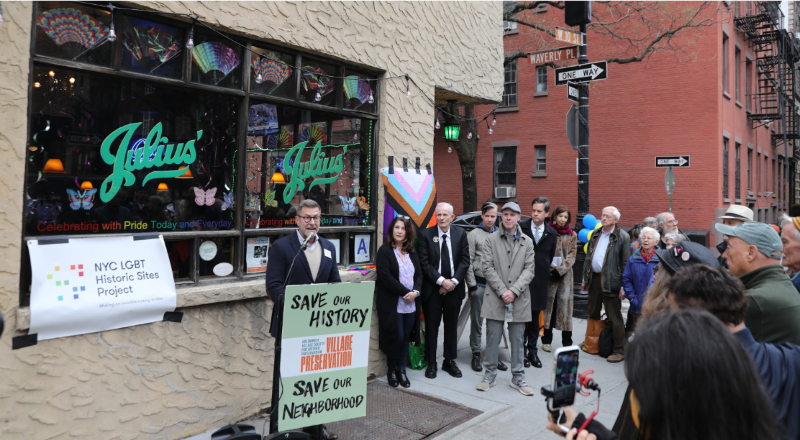
On April 21, 1966, members of the Mattachine Society, an early gay rights group, organized what became known as the “Sip-In” to challenge New York State Liquor Authority (SLA) regulations that were promulgated so that bars could not serve drinks to known or suspected gay men or lesbians, since their presence was considered de facto disorderly. The SLA regulations were one of the primary governmental mechanisms of oppression against the gay community because they precluded the right to free assembly. This was particularly important because bars were one of the few places where gay people could meet each other.
Mattachine members Dick Leitsch, Craig Rodwell, and John Timmons, accompanied by several reporters, went to a number of bars to document this discrimination. At Julius’, where they were joined by Randy Wicker, the group announced that they were “homosexuals” and asked to be served a drink — the bartender refused their request. This refusal received publicity in The New York Times and the Village Voice and was the first time LGBTQ discrimination had been proactively documented in mainstream media. The reaction by the SLA and the newly-empowered New York City Commission on Human Rights resulted in a change in policy and the birth of a more open gay bar culture. Scholars of gay history consider the “Sip-In” at Julius’ a key event leading to the growth of legitimate gay bars and the development of the bar as the central social space for urban gay men and lesbians.
Ken Lustbader, NYC LGBT Historic Sites Project: “Today we make an invisible history visible by installing a commemorative plaque on the exterior of Julius’ bar, an important location in LGBTQ history. In April 1966, courageous activists staged a ‘Sip-In’ to publicize the homophobic discrimination that the LGBTQ community experienced in bars, which could refuse them service if suspected of being homosexual. These pre-Stonewall trailblazers challenged the idea that LGBTQ people were second-class citizens — they deserved safe and welcoming places to socialize and build community. The NYC LGBT Historic Sites Project is proud to have undertaken extensive research and writing when nominating Julius’ to the State and National Registers of Historic Places in 2016 for LGBTQ history. Since then, we have nominated an additional ten sites directly associated with LGBTQ history. With the recent pushback of LGBTQ rights and attacks on queer people throughout the country, we’re proud to join with our partners at Village Preservation and Helen Buford, owner of Julius’, to formally memorialize this history with this tangible plaque. It will provide intangible benefits of identity, pride, and a connection to the past.”
Andrew Berman, Village Preservation: “As the city’s oldest gay bar and home of the pioneering 1966 ‘Sip-In’ protesting anti-gay discrimination, we are proud to be placing a plaque at Julius’ with our partners at the NYC LGBT Historic Sites Project to honor this uniquely important civil rights site. Three years before Stonewall, when being gay was still considered a crime, these brave individuals protested for their right to gather free from harassment and discrimination. This is part of a long tradition of pioneering efforts for civil rights for LGBTQ people, African Americans, women, immigrants, and many others rooted in this neighborhood, from the first free black settlement in North America located here in the 17th century, to the fight for Women’s suffrage here in the late 19th and early 20th centuries, to the Stonewall Rebellion and many other agitations for LGBTQ+ rights which took place here in the late 20th century. We’re thrilled to be able to add this site as our 19th historic plaque in our neighborhoods, which have marked the homes of figures from James Baldwin to Jane Jacobs, Lorraine Hansberry to LeRoi Jones, Anais Nin to Alex Haley. We’re especially proud given that in 2012 we were able to get Julius’ determined eligible for the State and National Registers of Historic Places, when few LGBTQ+ sites had ever received such a determination, and we continue to advocate for individual New York City landmark designation for the site.”
About the NYC LGBT Historic Sites Project
The award-winning NYC LGBT Historic Sites Project, launched in 2015, is the culmination of over 30 years of research and advocacy by its founders, who are national pioneers in the historic preservation of LGBT sites. Their initial efforts to nominate the Stonewall Inn to the National Register of Historic Places in 1994 came to fruition five years later, and further efforts secured the designation of Stonewall National Monument in 2016. The NYC LGBT Historic Sites Project has since nominated eleven more LGBT sites to the National Register, from James Baldwin’s residence on the Upper West Side to the Women’s Liberation Center in Chelsea. In addition, six LGBT sites that the Project recommended to the NYC Landmarks Preservation Commission, including the Audre Lorde Residence on Staten Island and the Gay Activists Alliance Firehouse in Soho, became city landmarks in 2019. The Project also highlights the city’s LGBT history beyond Greenwich Village with a website of nearly 400 diverse places in all five boroughs. Dating to the 17th century, these sites illustrate the community’s influence on NYC and American history and culture.
The Project further disseminates its work by providing walking tours (also accessible through a free app), presenting lectures, engaging the community through events, developing educational programs for New York City public school students, and sharing its content through robust social media channels. Its goal is to make an invisible history visible while fostering pride and awareness for LGBT people around the world.
About Village Preservation
Since 1980 Village Preservation (VP) has documented, celebrated, and fought to preserve the special architectural and cultural heritage of Greenwich Village, the East Village, and NoHo, successfully advocating for landmark designation of over 1,500 buildings, and zoning protections for nearly 100 blocks. VP places a special emphasis on civil rights and social justice history connected to our neighborhoods; in 1999 it was co-applicant for listing Stonewall on the State and National Register of Historic Places — the first time any LGBTQ+ site had ever been so honored in the country — and in 2015 successfully helped lead the campaign for individual NYC landmark designation of the site. VP has also successfully proposed and secured landmark designation of the former NAACP headquarters, the LGBT Community Center, the Gay Activists Alliance Firehouse, and the studio of Jean-Michel Basquiat, among other sites.
Village Preservation offers 80 public programs annually about our neighborhoods’ histories; a need-blind children’s education program focused on architecture, African American history, and immigrant history; dozens of online maps and tours, including our Civil Rights and Social Justice Map, with over 150,000 views; a 4,000 piece historic image archive; and a collection of over 60 oral histories with important figures in the civil rights, social justice, artistic, literary, business, and cultural history of our neighborhoods.
Web: www.nyclgbtsites.org & www.villagepreservation.org
Instagram: @nyclgbtsites & @gvshp_nyc
Twitter: @nyclgbtsites & @gvshp
Facebook: /nyclgbtsites & /villagepreservation
###
NYC’s oldest gay bar — home to major pre-Stonewall public action for LGBTQ rights — gets commemorative plaque
April 20, 2022
By: Muri Assunção
Julius’ Bar, New York City’s oldest continuously operating gay bar, and home to a pivotal pre-Stonewall public action for LGBTQ rights, is finally getting a commemorative plaque — 56 years after a group of gay men used their drink orders to fight back against bars that refused to serve members of the LGBTQ community.
The plaque, presented by the NYC LGBT Historic Sites Project in collaboration with Village Preservation, will honor Julius’ role in the ongoing fight for queer rights, as well as the site of the protest known as “Sip-In.”
On April 21, 1966, four members of the Mattachine Society, an early queer rights organization decided to challenge regulations adopted by bars to deny service to patrons who were seen as “disorderly” — a vague definition that New York City police used to refer to same-sex flirting, kissing or even touching.
Inspired by earlier sit-in demonstrations, protests enacted to desegregate diners in the American south, the four activists set out to expose the bigotry faced by the community at the time — three years before the Stonewall Riots, a series of violent protests often seen as the catalyst for a new phase in the fight for LGBTQ rights.
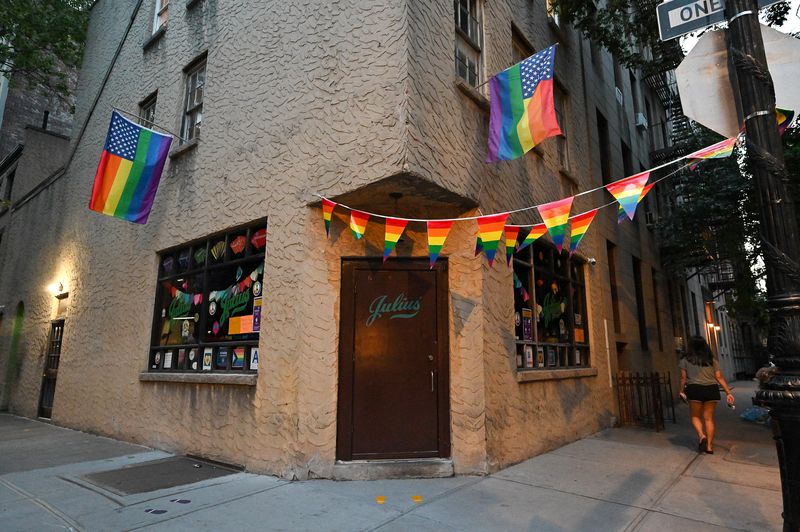
They invited some reporters and a photographer, ordered a drink at Julius’ and then declared that they were gay. The bartender refused to serve them, the story made it to the press, and their courageous action became instrumental in bringing attention to widespread anti-LGBTQ discrimination.
That pivotal moment in queer liberation history, known as the “Sip-In” at Julius’, is the first documented case of anti-LGBTQ discrimination in New York City, according to Ken Lustbader, Ken Lustbader, a historic preservation consultant and a co-founder of the NYC LGBT Historic Sites Project.
On Thursday, to mark Sip-In’s 56th anniversary, and to honor the listing of Julius’ Bar on the National Register of Historic Places, the organization, in collaboration with Village Preservation, is hosting an event to honor the bar — and the historic event.
Lustbader, Village Preservation’s Andrew Berman, as well as award-winning actor, screenwriter and director John Cameron Mitchell (“Hedwig and the Angry Inch”), will unveil a historic plaque to celebrate the bar’s legacy on Thursday at 6 p.m. ET at Julius’ Bar, at 159 West 10th Street.
They will be joined by Julius’ owner Helen Buford, as well as Randy Wicker, the last living participant of the protest.
“This is about visibility,” Lustbader told the Daily News, speaking of the importance of having a plaque on a building for people to “walk by and see where gay history took place.”
“It’s especially important now with the pushback of [LGBTQ] rights and visibility, and its impact on children to know that there were other people that fought and who were visible and understood what they went through.”
He added, “We’re hoping that future generations, including this generation, will understand the importance of visibility and being who you are, and paving the way for a person to feel whole and entitled to be who they are.”
Gay Greenwich Village (Instagram Live tour)
May 6, 2022 | 11:00AM - 12:00PM
Greenwich Village
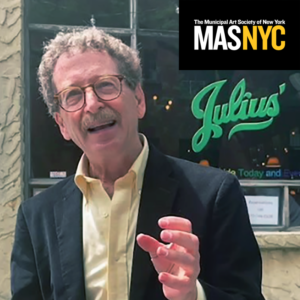 LED BY ANDREW DOLKART, NYC LGBT HISTORIC SITES PROJECT CO-DIRECTOR
LED BY ANDREW DOLKART, NYC LGBT HISTORIC SITES PROJECT CO-DIRECTOR
Join our co-director Andrew Dolkart for a virtual walk, in-the-field, discussing LGBT historic sites in Greenwich Village for Municipal Arts Society‘s 2022 Janes Walk events. Our 20-minute Instagram Live tour will center on Washington Square Park, itself the site of rallies and gatherings and, around it, former residences of notable individuals. Learn about the LGBT presence in the Bohemian Village and hear about the places and people of the pre- and post-Stonewall LGBT civil rights movement and their lasting impact on American culture.
ACCESSIBILITY
This walk will be virtual, hosted on Instagram Stories Live, and we will activate close captioning as well as monitor chat with questions and those in need of assistance.
Click here to follow @NYCLGBTSites on Instagram so you can follow along live on May 6.